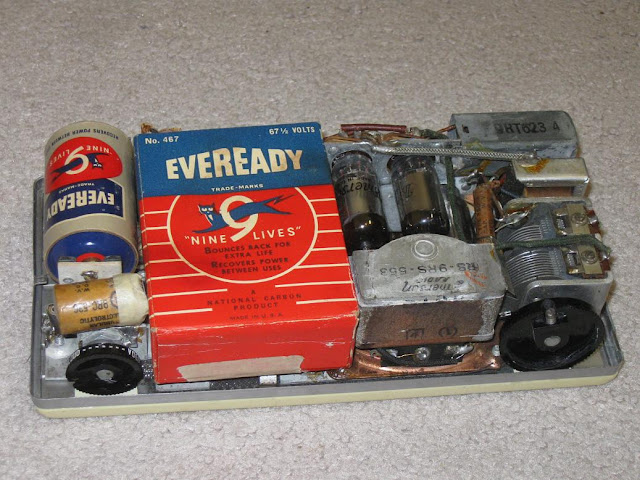In
the early days of radio a set that would fit in a pocket was something that sparked
the imagination of a lot of people. Of
course it really wasn’t possible in the 1920s or even during most of the 1930s. But, in 1939 RCA introduced a line of
miniature tubes that could be used to design a very small radio that had good
performance. In addition to the tubes
there was a need for a compact high voltage battery to power the radio. RCA again came to the rescue in 1940 when
they introduced a 67.5 Volt battery specifically designed for their compact
BP-10 portable radio.
The
BP-10 was a fair to good attempt at reducing the size of the radio. It had dimensions of 9.0” x 3.75” x 3.0”,
which was pretty small for the time. Its
performance wasn’t too bad either. The
four tube superheterodyne circuit was comparable to many table top radios of
that era. Still, it was not a radio that would fit in a
pocket, not even a very large coat pocket.
In
the late 1920s and early 1930s several radio manufacturers tried to sell what
was then known as “midget radios”. Table
model cathedral and tombstone radios were considered midget back then. But, by 1932 midget radio manufacturers were
folding almost as fast as new ones started.
An exception was the Emerson Corp.
Somehow the Emerson radios bucked the trend against midget radios. Emerson had pioneered a radio even smaller
than midget radios when they introduced the Emerson model 25 late in 1932. That was the first of the truly compact
radios. Orders for the model 25 poured
in for more than a year. Orders were
greater than production could sustain. From that point on Emerson was definitely
a company the public looked to for small radios. During subsequent years one of Emerson’s well
known slogans was: “World’s Biggest Selling Little Radio.” 1
By
1941 several radio manufactures were producing small radios similar to RCA’s
BP-10. They were all intended for
portable use in surroundings where AC power was not available. In 1940 Emerson introduced the models 379 and
380, which were small portable sets making use of the new RCA miniature tubes.2 But, at 110 cubic inches, the 379 and 380
were not as small as the RCA BP-10. So, not to be outdone, Emerson introduced their
model 432 in 1941 and advertised it as the”Power-Mite”. The “Power-Mite” was definitely a small
radio. In fact it was the smallest
superheterodyne radio available to the public prior to WWII.3 Zenith
called their small portable radio “Poketradio”, but it was much larger than the
Emerson 432 and would fit in very few pockets (see table 1).
Figure 1. The Emerson 432 “Power-Mite” could easily be held in one hand
Figure 2. The very crowded interior of the Emerson 432
Table 1. Some
Pre-war Personal Sized Portable Radios using Miniature Tubes4
Figure 3.
Although small, the Emerson 432 was just barely a pocket radio
The
small size of the Emerson 432 required special small components, such as a
variable capacitor, I.F. transformers, and speaker. All components were crammed into 81 cubic
inches with little volume left over. The
minimal remaining volume affected the acoustic performance. The Emerson 432 sounded very tinny compared
to other small portables. But, the fact
that it took up such little room somewhat made up for the poor audio
quality.
Figure 4. The
Emerson 432 (left) and the larger RCA BP-10 (right)
Electrically
the radio used a basic four tube superheterodyne circuit similar to other
radios of the period. Other than the
miniature components there were no novel electrical devices in the design. Consequently sensitivity and selectivity were
about on a par with radios like the RCA BP-10 and Motorola A1. Some minor changes were made to the 432
design prior to WWII, but the changes did not improve the performance. Figure 5 shows both an early and a late
version.
Figure 5. Pre-WII
versions of the Emerson 432 Early (left) and late version (right)
Although
the model 432 did not sell as well as the very popular RCA BP-10, Emerson did
not give up on the pocket radio market.5 After WWII Emerson improved
the design of the 432. The improvements
resulted in several Emerson models including the 508, 558, 569, 640 and other
“pocket portables”. All were basically
the same size and physical layout as the pre-war Emerson 432. The physical
layout pioneered by RCA, of a loop antenna in a plastic cover that could lifted
to turn the radio on, was copied not only by Emerson, but by many other radio manufacturers. That layout was essentially the most popular
configuration for small portable radios until the introduction of ferrite rod
antennas in the early 1950s.
Emerson
followed these small tube portables with an even smaller pocket portable, the
model 747. That led to the release of a
nearly identical hybrid tube/transistor model (model 856) in the mid
1950s. After that it was transistors all
the way. The 1941 pre war model 432 was
somewhat ahead of its time as a pocket set.
But, it was sincere attempt that primed the public’s interest for the true
pocket portables to come.
2 Radio and Television Retailing Magazine, McGraw Hill Publishing Co., August
1940, p38, Advertisement for the Emerson model 379 radio)
3 Schiffer, Michael
Brian, The Portable Radio in America,
1991, The University of Arizona
Press Tucson & London, p124
Press Tucson & London, p124
4
Radiomuseum (website), http://www.radiomuseum.org/act_main.cfm,
radio listings using 1S4 and 3S4 vacuum
tubes (1940- 1941
5 Warnagiris,
T., “Radio Wherever I go”, Antique Radio
Classified, February 2011, Vol. 28, No. 2,
p11






No comments:
Post a Comment